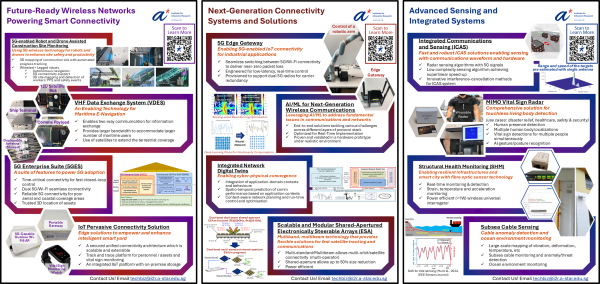Communications & Networks
A*STAR I²R focus on intelligent communications and networks solutions to enable national transformative digital innovation with focus and alignment to strategic national priorities. Our industry partners span across multiple sectors, including telecommunications, aerospace, maritime, transportation, shipping and logistics, power systems and smart grid, pharmaceutical manufacturing, fast-moving consumer industry, etc.
Our Communications & Networks core competencies are in the areas of:
Integrated Communications and Sensing
Integrated Communications and Sensing (ICAS) is gaining traction, particularly in the context of emerging technologies like the Internet of Things (IoT), smart infrastructure, and sensor networks.
ICAS has been defined as a new key usage scenario in International Mobile Telecommunications-2030 (IMT-2030). ICAS can potentially save spectrum, energy, and cost in enabling new applications that need communication and sensing at the same time.
Our research addresses challenges in ICAS design and implementation, including:
- System architectures design for ICAS to maximise the overall benefit.
- Innovative waveform design and signal processing.
- Protocols and standardization of ICAS in the 6G networks.
- Spectrum sharing and interference management.
- Full duplex operation for sensing and communication.
- Antenna design and beamforming.
- ICAS in THz band to achieve super-accurate sensing and ultra-high throughput communication.

Integrated Communications and Sensing
AI for Wireless Communications
Artificial Intelligence and its applications motivated researchers to leverage on AI techniques in both lower layer air interface, as well as higher layer networking, resource allocation, and scheduling.

Our research in AI for wireless communications spans across all layers of physical, networking, and application layers, targeting diverse use cases, including:
- Propagation channel type identification.
- Link adaptation.
- Beamforming design.
- Anomaly detection.
- Packet queue scheduling.
- Transmit power control.
- PA non-linearity compensation.
- Hardware impairments mitigation and system calibration.
Digital Twin for 5G/6G Communications Network

Digital twin is a digital representation of a real-world physical entity. Digital twin for communications network is useful in the following aspects:
- Network planning and dimensioning for new stringent sensing/actuation applications.
- Anticipating and optimising QoS performance given the complex interactions among competing services.
- Managing and maintaining network assets, which will include a much larger amount of equipment.
- Managing and leveraging collected data.
Our research focuses on the co-design of communications network digital twin and the digital twin for vertical applications such as intelligent transportation system (ITS), manufacturing, etc. to achieve joint optimisation whereby the two systems exchange status information and control for best possible realisation in the physical environment.
Sustainable IoT for Massive Communications
Aligning with Singapore Green Plan 2030 and the emphasis on energy sustainability, A*STAR I²R focuses on sustainable IoT research in these areas:
- Ambient/battery-less IoT.
- Backscatter communication.
- Reflective Intelligent Surface (RIS).
- Energy harvesting.
- Simultaneous wireless information and power transfer.

Network Reliability & Resilience for Mission Critical MTC
In critical information infrastructure (CII) such as smart grid networks and industry 5.0, reliability and resilience are of paramount importance. Our research addresses this challenge by developing innovative solutions to achieve ultra-reliable and low latency communications (URLLC), which include the following:
- Multi-protocol robust communication interface.
- Data-driven link quality prediction.
- Pre-emptive network switching.
- Enhancement features with resource reservation and aggregation.

Terrestrial networks / non-terrestrial networks 3D Networks

- Architecture, antenna, and payload design.
- Physical and network layer protocol design.
- Orchestration framework for 3D network.
- Resource planning, allocation, and optimisation.
Optical Sensing

Antenna and RF Design/Optimisation
- Metamaterial based compact wideband antennas.
- AI based antenna/RF component optimization and synthesis.
- Electronic beam steering array antenna.
- Sub-6GHz, mmWave, deployable antenna.
- Energy harvesting, and power efficient RF front-end.

Metamaterial-based mmWave Antenna Array and Antenna Calibration
Since the 2010s, A*STAR I²R dedicated efforts to various projects involving Metamaterial-based antenna arrays, metasurfaces and large array calibrations across different frequencies.
Our innovative solution addresses the issues faced by these antenna arrays and calibrations such as losses and mutual coupling between antennas due to traditional materials, larger array sizes with more complex excitation networks, increasing costs and power consumption. Additionally, the increased coupling between antennas complicates calibration and reduces the accuracy of beam control, hindering the formation and precise pointing of the narrow antenna beams. Consequently, there is a risk of failing to meet the required link budget.
We aimed to enhance radiation efficiency and minimise coupling. Some of our achievements have been licensed and recognised with national honours.

A*STAR celebrates International Women's Day

From groundbreaking discoveries to cutting-edge research, our researchers are empowering the next generation of female science, technology, engineering and mathematics (STEM) leaders.
Get inspired by our #WomeninSTEM

